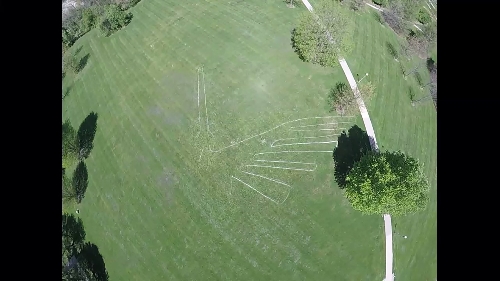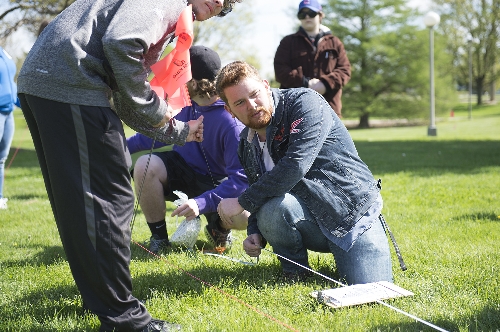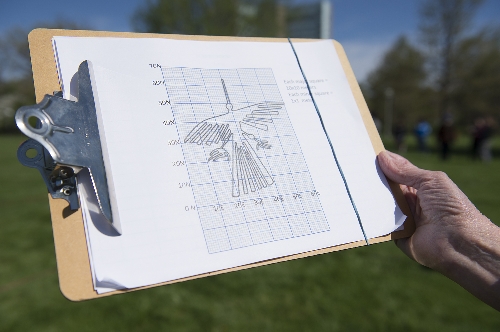University News
WIU Fantastic Archaeology Students Create a Nazca Geoglyph on the Macomb Campus
June 2, 2017
MACOMB, IL – As part of a new anthropology class at Western Illinois University, students of Associate Professor Patricia Anderson spent a Saturday in April creating a geoglyph on campus.
The experimental archaeological project was part of Anderson's class, "Fantastic Archaeology: Ancient Astronauts, Shape Shifters and Bigfoot." The culmination of the class involved a gathering of 11 students April 22 to replicate a geoglyph from the famed Nazca Plains of Peru, attributed to the Nazca Culture (1,500-2,000 years ago). The geoglyph was placed on Currens Field, the lawn between Currens and Thompson halls on the WIU campus.
The geoglyph duplicated a Nazca Condor, which Anderson said was chosen because its straight lines make it easier to create in a short amount of time.
"The Andean condor is the largest raptor in the world and is an important symbol in many South American cultures, past and present," said Anderson. "The Nazca original, which measures about 120 meters in length, is stylized with an elongated beak. The class attempted to recreate the immense geoglyph at half the size of the original."
Students consulted a scale version of the original on graph paper and measured over from a baseline to set points (golf tees) in the ground. Students then stretched cord from each point to connect the dots. Next, a student ran a chalk marker along the edge to create a negative outline of the condor in white lime on the green grass.
The class project was filmed from the air by a drone operated by senior Emergency Management and GIS major Edgar R. Rodriguez, of Macomb, who captured video and still images of the work in progress, as well as the end product.
The project, which was scheduled to last three hours, was stopped at noon. Although there was not sufficient time to complete the condor, Anderson said she considers the initial attempt successful because it closely resembles the head, beak and wing of the Nazca Condor, and the project served its educational purpose.
Junior anthropology major Emily Johnson, of O'Fallon, IL, said she found the project to be a great way to apply the techniques students learned through lectures.
"It allowed my classmates and me to have a firsthand experience creating a condor by plotting points, connecting them with string, and 'painting' over them with a chalk liner," said Johnson. "In addition, it was a great team-building exercise and showed that creating the Nazca Lines was a feat that the Nazca people easily could have achieved at the time. Overall, I would recommend ANTH 215 to any of my friends, and I felt that our class project was the icing on the cake."
Senior Foreign Languages and Cultures major Emma Formhals, of Macomb, said she thought the project showed how fun a hands-on learning experience can be.
"It really drove home the point that the people of the past were anything but primitive and were more than capable of the ingenious accomplishments that are so often accredited to the supernatural," said Formhals.
Students in the class created their geoglyph designs as party of the class. Senior Liberal Arts and Sciences major Carl Anderson, of Wyanet, IL, said he enjoyed learning about the creative and educational process behind creating geoglyphs.
"The overall execution of the project was easy to understand," he said. "In addition, I liked that we had active roles in the creation of the condor. We each took turns in looking at the schematic, laying out the points and the string and chalking the outline."
Anderson said her students uniformly agreed the Nazca lines could have been executed relatively quickly by the Nazca people with knowledge of the concept of scale and the use of a consistent unit of measure. In other words, extraterrestrial assistance was not required as has been argued in popular pseudoscientific publications and in TV programs by Erich von Däniken and others.
"This class was a lot of fun to teach, and I'm very proud of the great team effort that my students displayed in creating the condor," said Anderson. "However, this course also has a serious message--we need to be able to think critically about interpretations of the human past and how they may be used to serve agendas based in reinforcing social inequality or self-aggrandizement. The accomplishments of past cultures are truly fascinating and I look forward to exploring them with future WIU students."
The project was carried out in cooperation with Facilities Management Director Scott Coker; Ashley Katz, assistant director of the University Union; Chad Sperry, director of the WIU GIS Center and Assistant Professor Andrea Alveshere.
The project was completed with equipment donated by Anderson and her husband, Steven G. Monger.
ANTH 215 is available for general education credit (three semester hours in social science) and is offered annually from the WIU Department of Sociology and Anthropology, on the Macomb campus. For more information on the course, contact Anderson at PK-Anderson@wiu.edu.
Posted By: University Communications (U-Communications@wiu.edu)
Office of University Communications & Marketing




Connect with us: